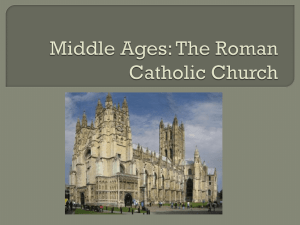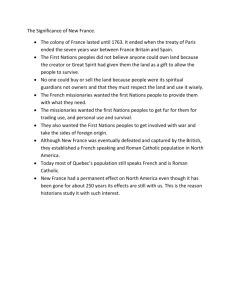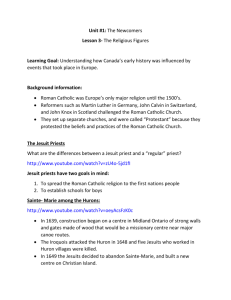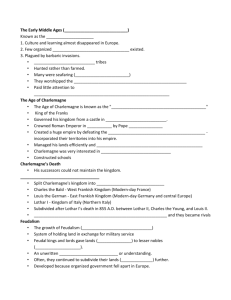The Roman Catholic Church in the Middle Ages
advertisement
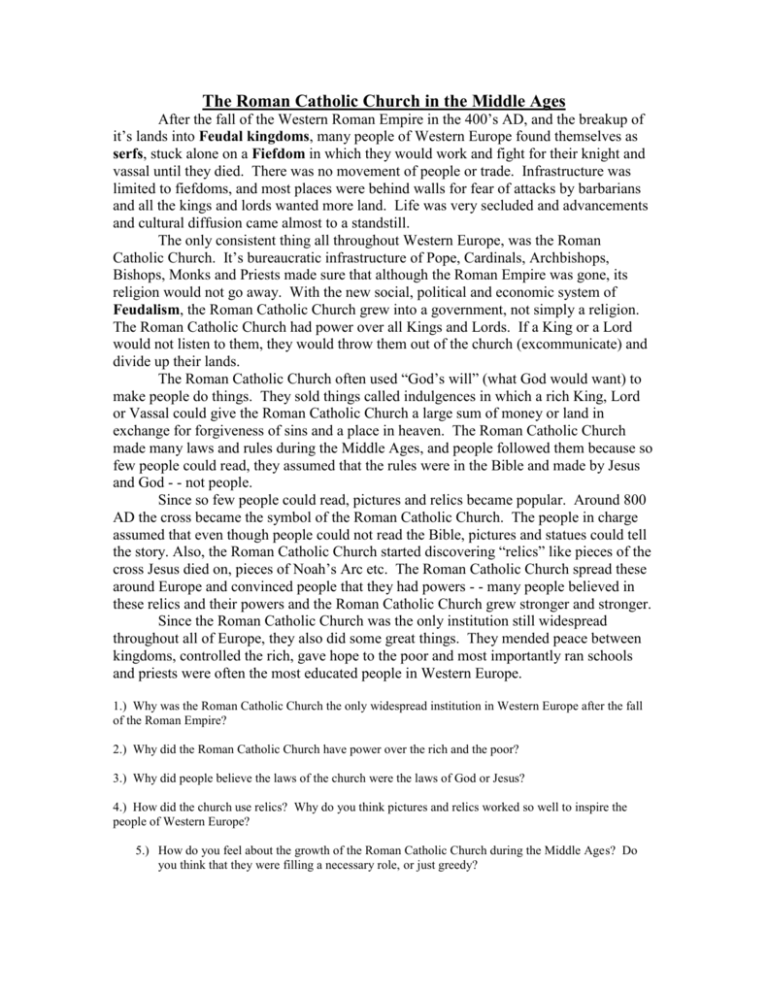
The Roman Catholic Church in the Middle Ages After the fall of the Western Roman Empire in the 400’s AD, and the breakup of it’s lands into Feudal kingdoms, many people of Western Europe found themselves as serfs, stuck alone on a Fiefdom in which they would work and fight for their knight and vassal until they died. There was no movement of people or trade. Infrastructure was limited to fiefdoms, and most places were behind walls for fear of attacks by barbarians and all the kings and lords wanted more land. Life was very secluded and advancements and cultural diffusion came almost to a standstill. The only consistent thing all throughout Western Europe, was the Roman Catholic Church. It’s bureaucratic infrastructure of Pope, Cardinals, Archbishops, Bishops, Monks and Priests made sure that although the Roman Empire was gone, its religion would not go away. With the new social, political and economic system of Feudalism, the Roman Catholic Church grew into a government, not simply a religion. The Roman Catholic Church had power over all Kings and Lords. If a King or a Lord would not listen to them, they would throw them out of the church (excommunicate) and divide up their lands. The Roman Catholic Church often used “God’s will” (what God would want) to make people do things. They sold things called indulgences in which a rich King, Lord or Vassal could give the Roman Catholic Church a large sum of money or land in exchange for forgiveness of sins and a place in heaven. The Roman Catholic Church made many laws and rules during the Middle Ages, and people followed them because so few people could read, they assumed that the rules were in the Bible and made by Jesus and God - - not people. Since so few people could read, pictures and relics became popular. Around 800 AD the cross became the symbol of the Roman Catholic Church. The people in charge assumed that even though people could not read the Bible, pictures and statues could tell the story. Also, the Roman Catholic Church started discovering “relics” like pieces of the cross Jesus died on, pieces of Noah’s Arc etc. The Roman Catholic Church spread these around Europe and convinced people that they had powers - - many people believed in these relics and their powers and the Roman Catholic Church grew stronger and stronger. Since the Roman Catholic Church was the only institution still widespread throughout all of Europe, they also did some great things. They mended peace between kingdoms, controlled the rich, gave hope to the poor and most importantly ran schools and priests were often the most educated people in Western Europe. 1.) Why was the Roman Catholic Church the only widespread institution in Western Europe after the fall of the Roman Empire? 2.) Why did the Roman Catholic Church have power over the rich and the poor? 3.) Why did people believe the laws of the church were the laws of God or Jesus? 4.) How did the church use relics? Why do you think pictures and relics worked so well to inspire the people of Western Europe? 5.) How do you feel about the growth of the Roman Catholic Church during the Middle Ages? Do you think that they were filling a necessary role, or just greedy? Charlemagne and the Frankish Empire In 768 AD a man named Charlemagne became king of the Franks. The Franks came from a region in Western Europe that is now France and Germany. Charlemagne was very smart, tough, charismatic (people were drawn to him) and a strict Roman Catholic. His father Pepin the Short, and his grandfather Charles “The Hammer” Martel had changed the Franks. Instead of having a bunch of small kingdoms, Charlemagne’s grandfather and father had fought the Muslims in Spain and unified a large kingdom that is today France and Germany. When his father, Pepin the Short had died, he split the kingdom into two halves – half went to Charlemagne, and the other half went to his brother Carloman. The two did not get along and both thought that they should rule the Frankish Empire, but they got along so they did not upset their mother, who was still alive. When their mother died however, Carloman mysteriously died soon after from an unknown cause…. and Charlemagne declared himself as king of all the Frankish Empire. Once he became king of all the Frankish Empire he began to expand it in the name of the Roman Catholic Church, he always kept in close touch with the pope. At first he conquered all of the remaining Pagan/Non Catholic barbarians in western and central Europe. As his armies of knights cut through Europe, he told the armies he defeated that he would spare their lives if they abandoned their Pagan/Non Catholic ways and became Catholic. Very often the defeated armies refused to abandon their culture and religion, and they were all killed. By doing this throughout Europe, Charlemagne: 1.) Built a large Empire, 2.) Spread Christianity and the power of the Roman Catholic Church, 3.) Ended Pagan beliefs in Western Europe. and vs. and After putting Western and Central Europe under his and the Roman Catholic Church’s control, Charlemagne set out to fight the fast growing Islamic Empire. He fought them in Spain and in the Mediterranean. These were the first battles between Christians and Muslims, and there would be many more. In 800 AD, Charlemagne was crowned Emperor of The Holy Roman Empire by the pope. In other words he was seen as the protector of Christianity. During his 47 years in charge of the Frankish Empire, Charlemagne tried his best to reconnect Western Europe. His empire used feudalism, and remained united only out of fear of Charlemagne. His largest contributions to history are his spread of Christianity and unification of Western Europe. 1.) What were some achievements of Charlemagne? 2.) What were some of the things he did that weren’t so “great”? 3.) Do you think Charlemagne was a great leader (like in the video), or do you think he was a brutal religious fanatic (like in the article)? Why? The Crusades In 1095 AD, Western and Central Europe had been carved up into many different rival kingdoms. These kingdoms (Frankish, Anglo-Saxon, etc.) practiced the social, economic and political system of Feudalism. There was little movement and contact between fiefs and kingdoms unless there was war between them. The only thing that was consistent throughout the region was the Roman Catholic Church. East of these kingdoms, the Eastern Roman Empire (or the Byzantine Empire) still existed. The Byzantines were also Catholic, but they did not really listen to the pope, and practiced the religion their own way without all of the new rules of the Roman Catholic Church. They practiced what is called Orthodox Catholic, which means “Original Catholic”. The Byzantines traded with Asia, practiced cultural diffusion and were much more advanced culturally and economically than the Western and Central Europeans. The Byzantines and the Roman Catholics were never at war, but had never really gotten along. HOWEVER, in 1095 the Byzantine Emperor Alexius I sent a letter to the pope asking him for military help against the Muslims which had taken over much of the Byzantine Empire, and he feared would soon take over the whole thing. Pope Urban II received the letter and saw his chance to give the Roman Catholic Church more power than they ever had before. Urban II have the famous “Sermon at Clermont” where he asked all able knights and serfs in the Roman Catholic Church to create a great army to take back Jerusalem from the Muslim. Even though Muslims had controlled Jerusalem for a very long time without it being a problem, Urban II convinced the men of Europe that Jerusalem had to be controlled by Christians. (Even though Muslims allowed people of any faith to live there freely.) By doing this he created an army that was made up of many different kingdoms and he showed the kings and queens of Europe that they had little power when it came to the Roman Catholic Church. ALSO, Urban II convinced so many men to join because he promised them something: He promised them that no matter what they had done in their past or future, they would go to heaven if they took part in the Crusade to take back the Holy Land. In 1096, many armies from all over Europe had assembled, the amount of soldiers that answered the pope’s call was more than even he expected. Over 100,000 troops began their journey east to take back the Holy Land. When they arrived at Constantinople, Alexius I had no idea what to make of the Crusader Army, he had just asked for a few hundred skilled knights to protect his lands! He did not even let the Crusaders inside of his city’s walls. He gave them supplies and told them to move on. At this point, many crusaders, after having traveled so long and so far, began to look for trouble. Once they entered Muslim lands, they began to take over cities, slaughter the people inside, and then take anything of value. Many crusaders gained a small fortune and turned around, many others declared themselves owners of land, and thousands and thousands died from fighting the Muslims, disease and hunger. They did not reach Jerusalem until 1099, and only 7,000 knights remained. Eventually they took the city because the Muslims had not anticipated this massive attack. Since many of the Crusaders had wanted it so bad for so long, and put up with such a brutal journey, they slaughtered everyone inside, even the many Christians and Jews that lived there. After taking the city, many crusaders went back to Europe, and eventually the Muslims took it back over. When they did, they proclaimed that Jerusalem was a free city again to all who wanted to live there. For the next 300 years popes ordered another 11 Crusades, but none of them took Jerusalem and all they did was create hatred between Christians and Muslims. 1.) The Crusades began as a holy journey to take back Jerusalem, what did they turn in to? 2.) Would you consider the Crusades a victory or defeat for the Roman Catholic Church? 3.) The Crusades helped the Europeans with cultural diffusion, explain. The Black Plague (Black Death) The Black Plague was a disease that arrived in Europe in _________. It came from fleas on ___________ and was brought to Europe by the __________ that had traveled with the ______________ on foot and on ___________. The first places that were struck were along _______________. When first infected with the disease, large painful swellings known as __________ began to appear all over an infected person’s body. The person would get a fever, cough up blood, and die within 4-5 days. What the people of Europe did not know, was that it was very ________________ . they did not yet understand microscopic disease, and therefore they could not stop the diseases spread. Within 4 years it had killed over __________ of Europe’s population. The results of the Plague on Europe were many. First off, many people lost faith in the ________________________________ for their inability to stop the spread of the disease. Also, monarchs became more powerful because of the outbreak of _______________ (lack of food) and war, when kingdoms began to compete for _____________. ________________ also changed. With so few people left to farm, knights, lords and vassals had to pay ___________ for their work.


